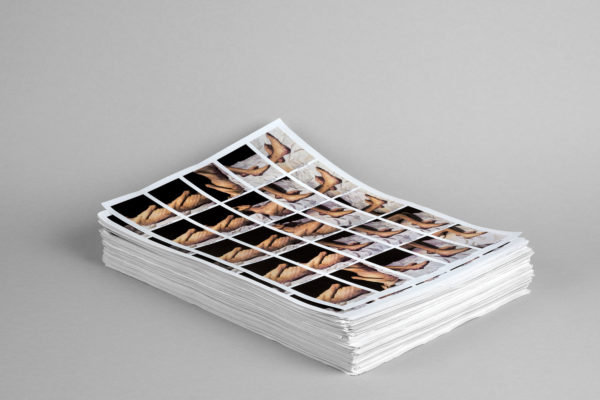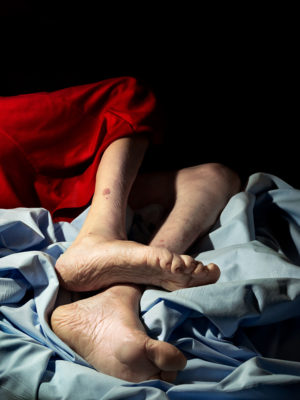Virginie Rebetez
Virginie Rebetez (1979, Switzerland) is based in Lausanne. She studied at the School of Photography in Vevey (CEPV) where she obtainted her CFC in 2003 and her diploma in 2005. She then moved to Amsterdam where she continued her studies in photography at the Gerrit Rietveld Academie; she obtained her Bachelor in visual arts in 2008.
Working for the past fifteen years on the subject of disappearance, loss and oblivion, her work is regularly exhibited in various museums, galleries and festivals in Switzerland and abroad – Galerie ConsArc (Chiasso, Switzerland), Three Shadows Photography Art Center (Beijing, China), La Maison Rouge (Paris, France), FORMAT (Derby, United Kindgom), Photoforum Pasquart (Biel, Switzerland), OCAT (Shanghai, China), Galerie C (Neuchâtel, Switzerland).
Her work has been awarded various grants and cultural prizes, such as the Irène Reymond Prize (2021), La Bourse Suisse des arts plastiques (2019), the Enquête photographique fribourgeoise (2018), the Leenards Foundation Grant (2014), the Swiss Design Awards (2014), among others.
Virginie Rebetez has also participated in several artist residency programs organized by Pro Helvetia in Johannesburg (2013), in Cairo (2016) and by the Canton de Vaud in New York (2014). She has published two books with Meta/Books (Netherlands), Out of the blue in 2016 and Malleus Maleficarum in 2018, both of which won awards. Her work is in several public and private collections.
Project
L'Inconnue
On November 11, 2014, the body of a lifeless woman was found in the Arve River in Geneva, Switzerland. Since the discovery of her body, “L’Inconnue de l’Arve”, as the police named her, has still not been identified. The investigation is still in progress, her body has been kept at the Institute of Legal Medicine in Geneva for more than 7 years now, and will be released by the justice system as soon as it decides to close the case. From there, no ceremony, no witnesses; in total anonymity, she will leave no trace.
At the end of 2018, Virginie Rebetez becomes aware of this case. Her project then focuses on taking care of her funeral, as soon as her body is released, so unknown she remains. She then began to make appointments with the various authorities concerned in order to inform them of her intentions and to learn about the possible steps to be taken. To become a “guardian” to honor, witness and recognize the existence of this woman. Then follows the waiting. Waiting for this body to bring “L’inconnue de l’Arve” out of the shadows, out of limbo, and to make her live; to let her die too. For three years, Virginie Rebetez has been waiting for this body that the justice system is unwilling or unable to let go. In order to prepare herself for its arrival and to familiarize herself physically and photographically with a lifeless body, Virginie Rebetez has been working with a thanotractor in her post-mortem care between 2018 and 2021. This collaboration resulted in some 3,000 photographs. Photographing these remains to sharpen her eye, to understand the fine line between what can be shown and what is unbearable and a way to get closer to “L’Inconnue de l’Arve”, to perceive her through these bodies.
Today, the project has split in two. On the one hand, the handling of the funeal as soon as the body was released, and on the other hand, the portrait in hollow that the waiting for this body gave rise to. The images of the hundreds of corpses taken during these three years raise broader and more universal questions about the representation of death and especially of the dead in photography. The images change over time. The distance to the bodies becomes flexible, changes, and eventually adjusts.
“L’Inconnue de l’Arve” thus becomes L’INCONNUE, a character that is no longer central but a point of departure that allows for questioning through other bodies. How to photograph a corpse? What can and should be shown? How to espace voyeurism or, on the contrary, romanticism? What are the consequences of censoring the dead body?
The unknown woman thus passes into the background to become a generic character. It is no longer She, but They, those who are not shown. Is a corpse without witnesses really dead? Did it really live? In the same way as a scene without witnesses, does it really exist?
What happens when the dead are deliberately erased for political reasons? For example, in Spain, it is forbidden to show a dead person photographically; how then can we hope to find the identity of the thousands of bodies that attempted to cross the Mediterranean, buried under X? The work of identification is almost impossible. The question of the representation and visibility of the corpse is all the more interesting today since Spain is exhuming its bodies from the civil war, at the same time as it is hiding those who seek refuge on its soil.
L'Inconnue is a project that extends the reflections around the representation and visibility of the dead body. It also questions and highlights the importance and significance of the photographic gesture. To recognize a life, an identify, literally and figuratively; to make visible in order to consider and make exist.
For Virginie Rebetez, the process should allow her to add a dimension to the already existing project by extending her research around this central idea of the representation of the corpse in photography.











